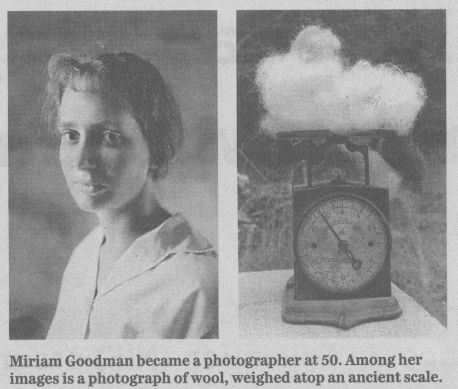Miriam Goodman, 69; poet also nurtured others' art
By
Bryan Marquard
Globe Staff
/
May 16, 2008
Photos and words, the parentheses that clasped Miriam Goodman's creative life, mingle in "Radiation Journal," a chronicle she kept on her Web page during treatment for cancer that had metastasized.

At times, she wanted to avert her glance as she traversed the landscape of illness in Massachusetts General Hospital.
"When I see the patients in the waiting room, looking reduced, I want to run," she wrote, "but that isn't allowed."
Instead, as she had for decades, Ms. Goodman trained perceptive eyes on her surroundings. With sentences and snapshots, she captured the humanity of the experience and the mysterious grace of cold steel healing machines.
A poet for many years, Ms. Goodman decided at 50 to become a photographer and taught classes that merged the visual and writing disciplines. She died Sunday in Chilton House, a hospice in Cambridge, of complications from cancer. Ms. Goodman, 69, had lived in Arlington and previously resided in Somerville, Cambridge, and Provincetown.
"There was nothing that she didn't mine for messages of beauty," said Leslie Lawrence of Cambridge, a friend who teaches at Tufts University.
Those messages, though, were not always meant to soothe.
"She did like to be brave in her work," Sarah Goodman of Peaks Island, Maine, said of her mother. "My daughter was actually talking about this today. She said, 'Grandma was always very provocative.' She thought good art would challenge you and really bare your soul."
In portfolios on miriamgoodman.com, Ms. Goodman trained her lens on everything from children to decrepit buildings. "Elevator portraits" is just that: people caught between floors in uneasy, transitory moments waiting for the doors to open.
One collection celebrates Nelson, a tiny town in southwest New Hampshire where Ms. Goodman spent summers in a cabin. Nestled among images of rural living is a photograph of shorn wool, weighed atop an ancient scale.
"Time's accumulation materialized in writing, photographs and paintings - a stream that wouldn't dry up," she wrote in a short essay elsewhere on the website. "Life wouldn't end. Our bodily ills would not aggregate to decay."
Still, not every emotional season was summer in her art. Ms. Goodman published three collections of poetry and included on her website selections from her most recent book, "Commercial Traveler." A section of one poem begins:
The day he took me walking, his eyes were on another
woman, strolling in a summer dress across the street.
Between us, there was icy weather.
Miriam Anne Schaeffer grew up in New York City, in Jackson Heights, Queens. Her father taught art and was adept at commercial work in photography, calligraphy, and design.
She graduated from Brandeis University, where she studied English. At 18, she married Robert Goodman, who became an architect, urban planner, and, for a time, an architecture critic for the Globe. He now teaches at Hampshire College and lives in Northampton.
Their marriage ended after about a decade, and the two shared custody of their daughters Julia, who now lives in Arlington, and Sarah. The couple remained close and Ms. Goodman, an only child, thought of her sisters- and brothers-in-law as her own siblings. The Goodmans' daughters, meanwhile, alternated years with each parent.
"We were the two little women and the one big woman in the house," Sarah said. "We were very close."
Close enough that Ms. Goodman's creativity was part of the girls' upbringing. She sought feedback about poems in progress from her daughters, who slept within earshot of the writing process.
"I wondered how many people who visited remember the sound of her electric typewriter going on, this sound of gerbils in her bedroom all night," Sarah said.
Working as a technical writer at Lincoln Labs and for high-tech companies, Ms. Goodman gained experience that informed the imagery of some poems. The work also prepared her for artistic changes ahead when she used computers and websites to blur the line dividing written and visual expression.
Ms. Goodman's first two collections of poetry, "Permanent Wave" and "Signal::Noise," were published by Alice James Books, and she received fellowships for stays at the Fine Arts Work Center in Provincetown, the McDowell Colony in Peterborough, N.H., and the Ragdale Foundation in Lake Forest, Ill.
Leaving the city for fellowships and her summer retreat were restorative for Ms. Goodman, who climbed Mount Monadnock in New Hampshire annually and taught her daughters to identify birds, tracks, plants, and trees. The haunting, melodic songs of the wood thrush and hermit thrush were favorites, her daughters said.
Just as she combined words and images in her art, Ms. Goodman liked to mix together friends from different parts of her life, inviting them to visit.
"In Miriam's home, you're surrounded by paintings and photographs and music and the smell of good cooking - she made the best chicken," said a sister-in-law, Ruth Goodman of Cambridge. "There would always be flowers in the house, light coming in."
At the cabin in New Hampshire, "she invited musicians," Lawrence said. "We would have string quartets on the porch with lots of good food and laughing. She made it into a salon."
And yet, amid the swirl of socializing, the demands of parenthood, and the responsibilities of work, Ms. Goodman never lost sight of the drive to create.
"She always put one's art first," Lawrence said. "She was interested in everything, about everyone and the world, but more than anyone else she'd say, 'How's your writing? Don't forget to make your writing primary when making decisions.' "
In addition to her daughters, her former husband, and sister-in-law, Ms. Goodman leaves two grandsons and a granddaughter.
A memorial service will be held at 11 a.m. today in Temple Shir Tikvah in Winchester.
© Copyright 2008 Globe Newspaper Company.
![]()
